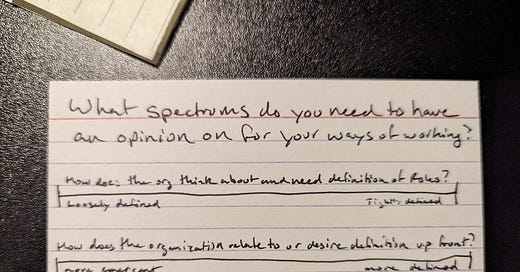Lately, as I have been thinking about intention and desire, one of the things I have been thinking about is how to make that practical for people. Like, it’s one thing to say, “We want to go <here>…” but I think it’s also important to acknowledge where you are at now, and that those two points exist on a spectrum of context. It’s not just that you are in one spot one day, and then you are in another spot the next day.
To give credit where credit is due, I think this has been primarily shaped by Esther Derby, Johanna Rothman, and from when I went to LeanAgile and saw Julia Wester talking about the concept of “lagom”
Why thinking in spectrums can be helpful
It helps to breakout of binary thinking, that something needs to be either this or that. It opens possibilities for people to consider rather than a simple I/O concept. It can also help you understand your current location versus where you want to be, and when you combine several spectrums together, it can help you and your team figure out where you might want to focus your improvement efforts.
A few spectrums that might be helpful when thinking about your ways of working
While spectrum thinking can be applied to LOTS of aspects of our ways of working, there are some that have stuck out to me recently that I have captured on my notes cards. I framed these mostly with an orientation toward the people involved. I’m not sure if that’s a good thing or a bad thing, however I can say that I was trying to put myself in people’s shoes in thinking about their experience versus their preference.
How does the org think about and need definition of roles?
I framed the spectrum here as “loosely defined” to “tightly defined”
This first one can be pretty interesting in terms of how it might impact your team’s ways of working. If the team or organization desires and sometimes even needs more definition around roles and responsibilities, that could be a barrier to implementing some ways of working. The more an organization and its people feel the need to establish roles, the more time might need to be spend on what success looks like for those roles, and the more siloed people might become.
It’s also worth noting that the larger an organization, typically the more defined the roles tend to get, and the more people expect definition around the roles. This seems to be a function of smaller organizations / teams needing to have people wearing multiple hats, and larger organizations requiring more structure to stay in alignment with each other and maintain clarity. Not a hard and fast rule, but more a heuristic.
How does the organization relate to or desire definition up front?
The scale here is “more emergent” or “more defined”
This second one can be pretty interesting from a few angles and feels like somewhat of a variation on Johanna Rothman’s “Do you need an agile approach?” where she asked about determinism required for the product. Part of what I wanted to hone in on with the way I am asking the question is more the comfort level of the organization / team and its people.
Getting clear about this spectrum can again help the team understand what ways of working might be appropriate or not based on level of comfort of the team members. That may or may not be a match for the needs of the product, so that might something to consider. If you have a product that has a high amount of discovery needed in its creation but the team isn’t comfortable with that concept, you might have a problem on your hands.
How does the organization prefer change / change frequency?
I framed the spectrum here as “incremental” to “all at once”
This last one on the card is trying to help orient around the preference of the people when it comes to change. If the people are more used to big bang type events and have developed more preference around what feels like “all at once” or bigger, less frequent changes, then trying to have them work in incremental improvements is going to feel awkward, and perhaps be difficult to implement. They may have trouble making time to do small improvements because it just might not feel important enough compared to other work; it might not feel “big enough” to merit action compared to other work.
Getting clear about this spectrum can help people understand how to approach change, and what hurdles might be encountered when trying to effect change in a different way than people are used to and perhaps prefer experiencing. If you want to shift more toward incremental, you may have to work to establish different habits and expectations around change and improvement.
Tip of the iceberg
These are just a couple of the spectrums I’ve captured that can be considered when it comes to change and ways of working. There are tons more that can be considered, and I will probably explore more of these in the near future.
If you found this helpful, let me know!



